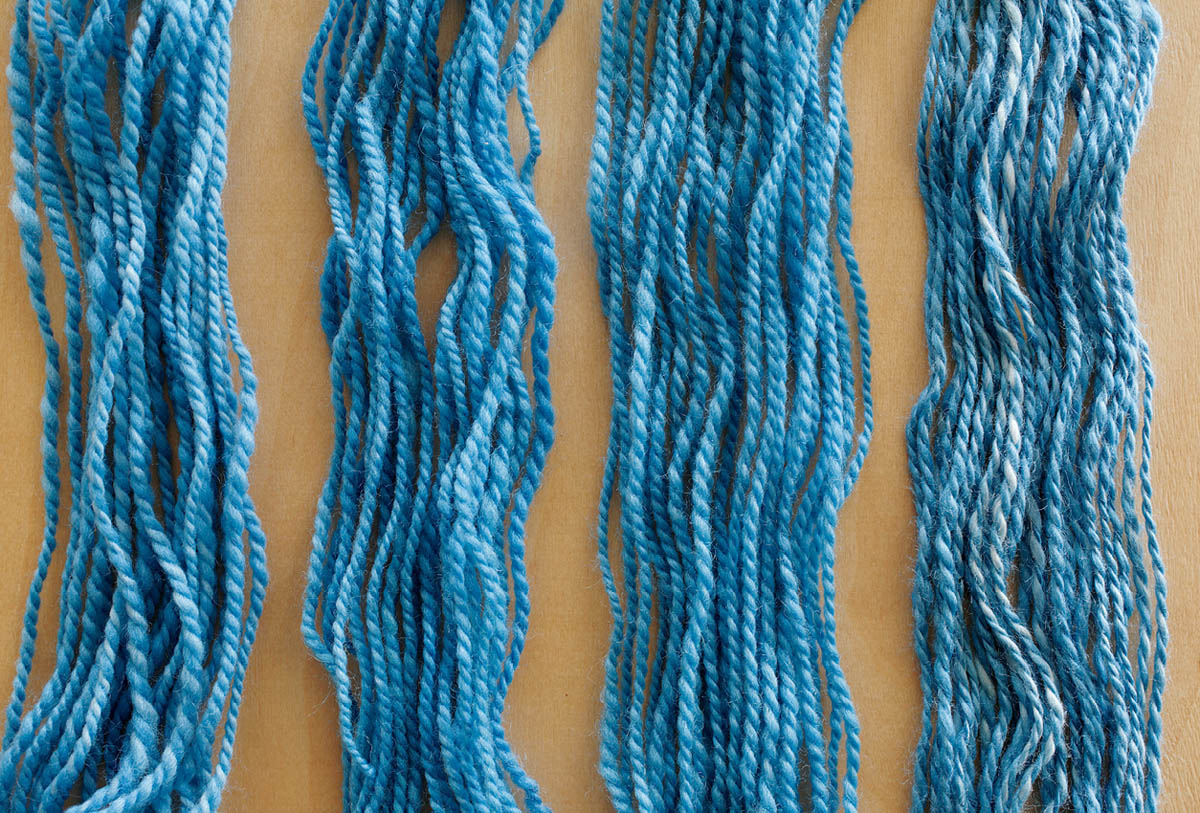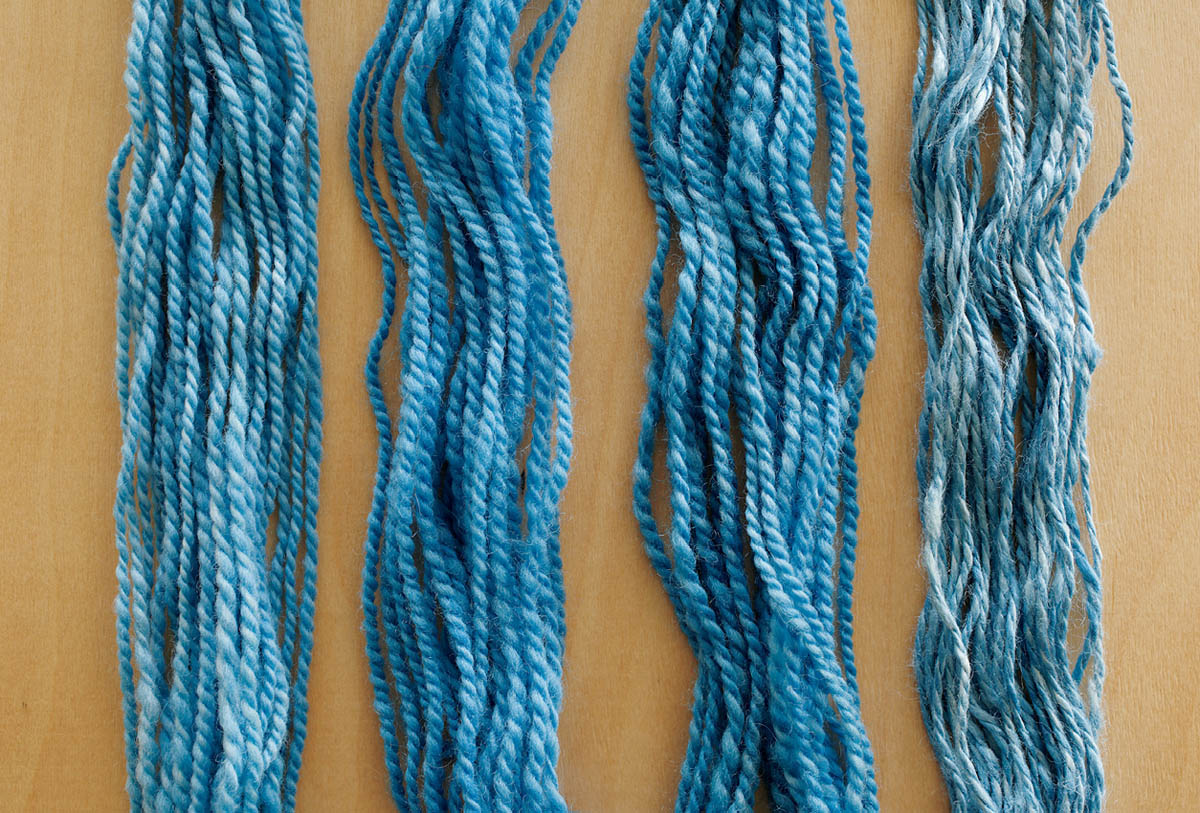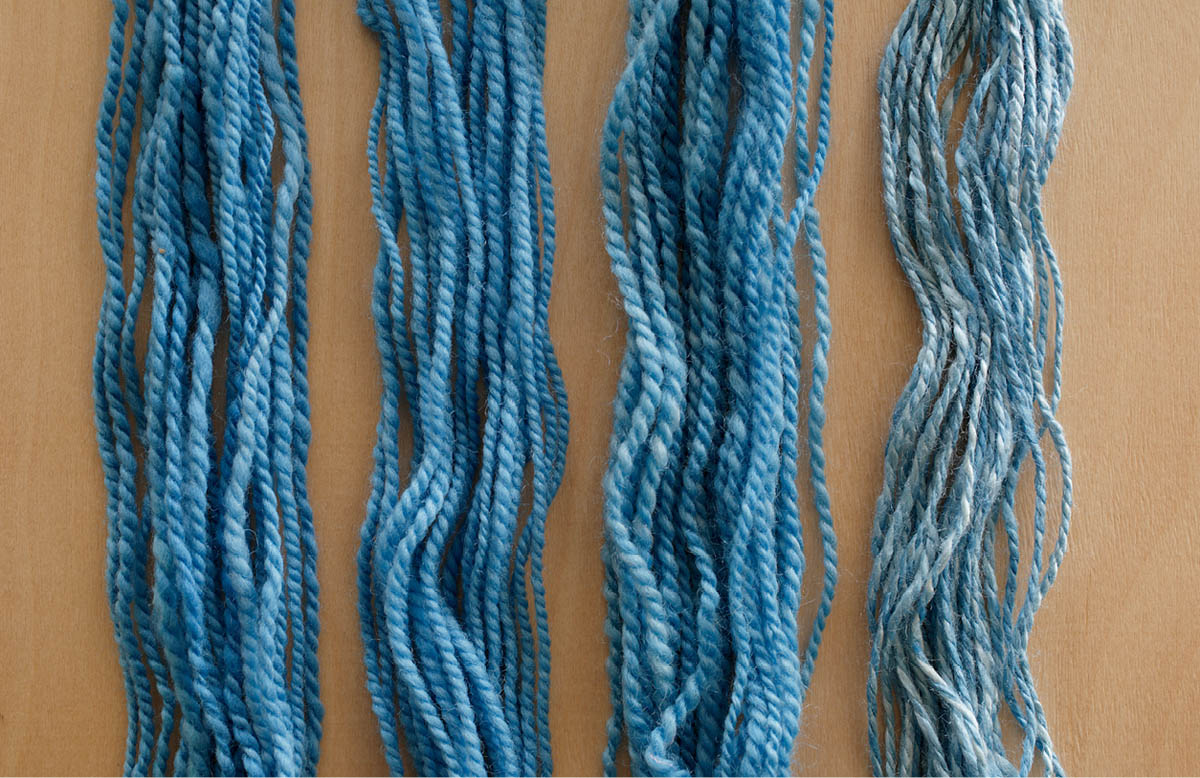
Finishing is one of the last things done to yarn before knitting with it, but it’s one of the first things people notice. Each method of finishing has a distinct effect on the look, and sometimes the feel, of the finished yarn as well as the knitted fabric. I have seven different ways of finishing my yarn, and, yes, I always finish my yarn. Why? Finishing helps the ply twist even out throughout the skein. I also think that the application of steam or hot water helps the yarn relax into itself, resulting in a yarn that’s easier to knit. With each method of finishing, I hang my skeins to dry. Sometimes, if the weather cooperates, I hang them outside; other times, if I’m in a hurry, I hang them inside with a fan blowing on them.

I steam yarn in several ways. If I’m working with small samples, I use my electric kettle or a wide soup pot of boiling water. I hold the skein in the steam with a pair of plastic tongs, rather than use a steamer basket sitting inside the soup pot. (I find that using a steamer basket gets my yarn almost as wet as when I wet-finish it.) I use tongs to hold the yarn in the steam for about 20 seconds, remove it from the steam, rotate the yarn’s placement in the tongs, and steam it again. I repeat this until I have completely rotated through the skein. For really big skeins or a large number of them, I use a garment steamer, following the same procedure as described for the kettle or pot of water. Or I sometimes steam the skeins flat on the floor by spreading them on towels and then slowly running the steaming nozzle over the circumference of each skein. I flip the skeins over and repeat.
Pro: This method is quick because there’s almost no drying time.
Con: I don’t think the fiber and twist move as much with steam as they do when submerged in soapy, hot water.
Good for: Tender yarns, art yarns with many things added in that might come off when soaked in hot water; any yarn that you feel needs only a light finish.
I soak yarn in warm to hot water and a no-rinse wool soap, such as Soak or Eucalan, for 10 to 15 minutes. Next, I remove the yarn from the water, lightly squeeze it, roll it into a towel, and compress the towel to get more water out. I then hang the yarn to dry.
Pro: Easy; the hot water relaxes the yarn and redistributes twist somewhat.
Con: Drying time; finding a place to hang the yarn, especially in a cold climate in the winter; doesn’t redistribute ply twist much.
Good for: Low-twist yarns.

To give yarn a thorough soaking, immerse it in warm to hot water with a no-rinse wool soap for 10 to 15 minutes.
Soak the yarn in hot water with wool wash, and roll it in a towel. Before hanging it up, snap it. To do this, put your hands inside the skein, like you’re going to play cat’s cradle, then move your hands apart quickly, and snap the yarn — not hard enough to break it, but hard enough to get some water sprayed in your face. Do this about four times, sliding the skein around your hands so that different areas of the yarn lie across the backs of your hands for each snap. I love how that little motion evens out the twist. This is the way I finish yarn most of the time.
Pro: Excellent redistribution of twist.
Con: Can break fine, low-twist yarns.
Good for: Almost all fibers.
This is a method I learned from my students. I follow all of the steps I do for soaking, but before hanging the skein to dry, I take it outside and twirl it above my head like a cowgirl with a lasso. It works! Do this three or four times, moving your hand to a different spot on the skein before each swing. The centripetal force of the swinging forces the extra water out. Combining swinging with a berserk war whoop or a “yee-haw” makes this method entirely entertaining.
Pro: Scares the neighbors; really gets the extra water out; cuts down on drying time; fun.
Con: Scares the neighbors; needs nice weather.
Good for: Medium to strong or fine fibers spun and plied for durability.
Then there’s whacking — a favorite of mine when I’m irritated at someone. I soak and roll as for the first methods, but before I hang the skein to dry, I beat the snot out of it. I literally hold one end of the skein and whack it against the floor, counter, deck, or table. I then move my hand to a new spot on the skein and do it again. This method abrades the surface of the yarn slightly. If a fiber or fiber blend is inclined to be fuzzy or puff, whacking will get it there fast. If you want a smooth-surfaced yarn, don’t whack.
Pro: Redistributes the twist a lot; fun.
Con: Abrades the surface of the yarn slightly; depending on the fiber content, can make yarns fuzzy or even start to pill.
Good for: Unevenly plied yarns; yarns that want to be fuzzy.
Fulling is the process of giving your yarn a slight felting, just a mere drawing in of fibers. For this, I use a bowl of water as hot as I can stand to put my hands in and a bowl of ice water; I add a drop or two of wool wash to the hot water. I soak the skein in the hot water, remove it from the water, barely squeeze it in my hands, and then soak it in the cold water, again barely squeezing it over the cold water. I move the skein back and forth between hot and cold, letting the yarn soak up the water for a minute or two in each bowl, not agitating, just squeezing most of the water out between bowls. This fulls the yarn, giving it a light felting. It firms up the yarn and pulls the fibers together a little. It also evens out the twist and stabilizes the yarn. This is my favorite finishing for singles.
Pro: Stabilizes singles yarn; redistributes twist.
Con: Works for anything you want to be more durable and fluffier, but not anything labeled superwash.
Good for: Singles destined to be knit as is.
My last finishing technique is the full-on menace: felting your skein. I learned an easy way to do this without burning your hands in spinning superstar Judith MacKenzie’s class: use a sink plunger. I add a drop or two of wool wash to a bowl of really hot water from my teakettle and place it next to a bowl of ice water. I move the skein back and forth from hot to cold, but not gently. I menace that skein with a small sink plunger, like a sink backed up after a hair-dyeing slumber party. I’ve never taken it to hard, stiff felt, but I’ve gone to firm. The whole look and feel of the yarn changes, and it resists pilling. Judith recommends this method for downy undercoats, such as cashmere: they don’t felt, and it makes them gorgeous and puffy.
Pro: Increases the durability of a yarn.
Con: Only works for wool and wool blends; can’t undo; shortens yardage.
Good for: Downy undercoat fibers, such as cashmere, that don’t felt; wool and wool blends.
I’ve learned that for any question about spinning, particularly spinning to knit, the answer is always “Well, it depends.” But everything depends on the fiber used, as well as the draft, the ply, and the finishing. Here are the seven finishing methods described in this chapter, on four different fibers. All seven are applied to top that has been drafted woolen, then spun into 2-ply to balance.
In each of these photos, the yarns are arranged in the following order, from left to right: Merino, Corriedale, Bluefaced Leicester, tussah silk.

Unfinished

Steamed

Centripetal force

Whacked

Soaked

Snapped

Fulled
Sometimes the differences between finishes don’t show until a yarn is knitted. The knitted swatches are arranged in the following order, left to right: Merino, Corriedale, Blueface Leicester, and tussah silk.

Unfinished

Steamed

Soaked

Snapped

Centripetal Force

Whacked
Some spinners set their yarn under tension by letting it dry with weight attached to it to take out the overtwist. There’s a reason it’s not a great idea to do this. I use my yarn mostly to knit, and when I weight or tension-set an overtwisted yarn and then knit with it, most of that overtwist comes back when I put the finished item in water to block it. Setting a yarn under tension is done by many spinners for effect, as well as for different fiber crafts than knitting, but when you’re going to knit with it, it’s only a temporary fix. Weighting a yarn takes all of the natural elasticity out of it, and weighted yarns therefore always seem a little limp (see the example on the facing page). You swatch and knit with it, and it looks lovely. You block your knitting — and sproing! The extra twist comes back. Even a fiercely pinned blocking can’t get it all the way back to its stretched and tensioned state. Sometimes your knitting looks okay, but sometimes it’s not quite right.
There are things to be done with overtwisted yarn that don’t involve tension or weighting. The easiest one is to run it back through your wheel to take some of the twist out. Using the twist on purpose to give a piece visual motion in knitting is beautiful, as you can see if you check out master spinner Kathryn Alexander’s work.